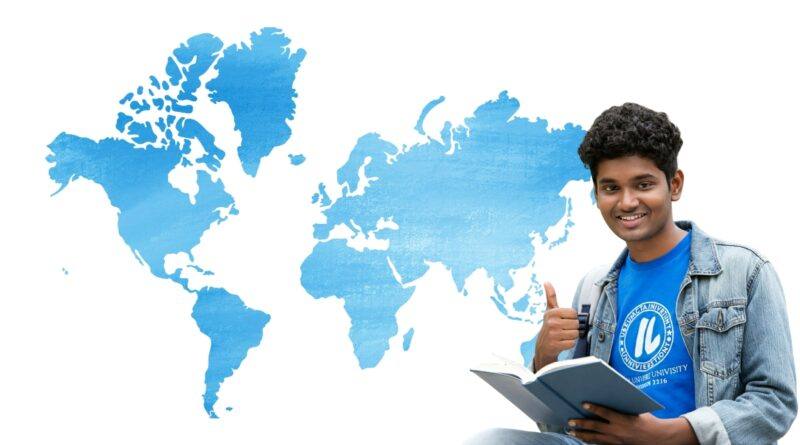Indian Students Now Have Better Choices In The World
By The WFY Bureau Desk | September 2025 Edition | Academics
Indian Students Redraw the Global Education Map
For decades, the Indian dream of studying abroad had one unquestioned destination: the United States. The Ivy League, West Coast tech universities, and a sprawling network of community colleges drew tens of thousands of young Indians every year. Families invested heavily, often viewing an American degree as both an academic passport and a migration pathway. But the tide is turning. Today, Indian students are broadening their horizons, seeking alternatives beyond the US, guided by new opportunities, changing visa regimes, and sharper financial reasoning. Germany, the Middle East, Ireland, and other regions are emerging as strong magnets for young minds who want quality education without insurmountable debt or uncertain prospects.
This transformation is not just about numbers. It reveals a deeper shift in priorities — away from the old model of education as a stepping stone to permanent residency and towards education as a carefully weighed investment in career outcomes, skills, and global exposure.
India–Germany: A Renewed Academic Bridge
The India–Germany agreement on gratis visas for student exchanges has come at a crucial time. It signals not only a diplomatic gesture but also a recognition of the way educational ties can anchor a larger strategic partnership. The provision for free short-term visas for school and college visits reduces barriers for collaborative projects, summer schools, and research exposure. For Indian institutions that often struggle to internationalise their classrooms, such arrangements can bring more of their students into contact with global peers.
Germany already enjoys a reputation as one of the most student-friendly destinations. Its public universities charge negligible tuition compared with the astronomical fees of the US or the UK. Even in its private sector, the costs are more manageable, especially given the long-standing policy of allowing part-time work for international students. German engineering, medical, and management degrees are highly regarded, while the country’s emphasis on research and applied sciences aligns well with India’s growing pool of STEM aspirants.
The data tells its own story. Between 2022 and 2025, the share of Indian students choosing Germany rose from around 13% to more than 32%. That is a remarkable surge in just three years, far outpacing growth in the US and Canada. The attraction is obvious: lower cost, clear pathways to employment, and a strong economy hungry for skilled workers.
Why the US Is Losing Its Shine
It would be simplistic to say the United States has lost its pull. It remains home to many of the world’s top-ranked universities, with unmatched networks and research ecosystems. But the obstacles have grown. Applications from Indian students fell by around 13% in 2024–25, reversing years of expansion.
Visa restrictions, unpredictable policy shifts, and skyrocketing tuition fees have all contributed. Families who once stretched every rupee to send their children abroad are now recalculating the risk. If the cost of a four-year undergraduate programme crosses ₹1 crore, many are asking whether that investment can be justified, especially when the post-study work landscape has become less welcoming.
For some, the US still makes sense — particularly those targeting elite programmes with high returns. But the mass wave of middle-class Indian students treating America as the default choice is ebbing.
The Middle East: A Pragmatic New Frontier
Parallel to Europe’s rise, the Middle East is becoming an unexpected but pragmatic hub for Indian students. The UAE, Qatar, and other Gulf states now host branch campuses of world-class universities such as Carnegie Mellon, Georgetown, and Weill Cornell. These institutions offer the same degrees as their home campuses, but at lower cost and with cultural proximity to India.
The appeal is practical. Flight connectivity is strong, living expenses are moderate compared with the West, and the Indian diaspora already forms a huge support system. In 2024, around 42% of international students in the UAE were from India — a staggering proportion that underlines how the Gulf has quietly become a centre of transnational education.
These opportunities are reshaping choices for students who want international credentials without the financial burden of the West. A student completing a degree in Dubai or Doha can often save 30–40% in costs compared with studying in the US or UK, while still benefiting from global faculty and curricula.
Financing the Overseas Dream: Loans on the Rise
One of the starkest findings in recent years is the shift in how Indian families are financing education abroad. Earlier, a significant share was covered through parental savings or extended family support. Today, one in three students relies on education loans. Debt has become the single-largest funding source.
This reflects both rising costs and widening access. With the growth of specialised non-banking financial companies (NBFCs), public sector banks, and private lenders, students from Tier 2 and Tier 3 towns now have options that were once unavailable. In fact, more than half of overseas education aspirants now come from state board schools in smaller towns, not just elite CBSE or ICSE institutions in metros.
Budgets are tight. About 40% of students plan within the ₹10–20 lakh range, while another 34% budget for ₹20–30 lakh. The rest stretch beyond ₹30 lakh, but only a small minority can afford costs upwards of ₹1 crore without loans. This explains why destinations like Germany, with its negligible tuition fees, or the UAE, with its shorter and more affordable programmes, have surged in appeal.
The Shift from Residency Dreams to Career Logic
For years, the prospect of permanent residency in the US, Canada, or Australia was a major driver of the study-abroad boom. That is no longer the case. Only around 16% of students now cite residency as their main goal, compared with nearly half just a decade ago. Instead, career advancement has taken centre stage. Close to 50% of aspirants say better jobs and rapid return on investment are their top priorities.
This change is reflected in course preferences too. Master’s degrees, especially in management, technology, and applied sciences, dominate applications. Over 85% of Indian students going abroad now aim for postgraduate qualifications rather than undergraduate degrees. The logic is clear: invest in specialised skills that improve employability quickly, rather than spending vast sums on four-year undergraduate degrees with uncertain returns.
Language Barriers and Cultural Shifts
Interestingly, language is no longer the barrier it once was. Indian students traditionally gravitated towards English-speaking nations, but that mindset is changing. The rise of France, Finland, and especially Germany as study destinations shows a new confidence among students in adapting to non-Anglophone environments. Universities offering English-medium programmes, combined with global exposure, make these countries less intimidating.
Cultural affinity also matters. For many, the Middle East offers familiarity in food, festivals, and community, while still providing exposure to global academic standards. Europe, meanwhile, appeals to those seeking both diversity and a chance to experience new lifestyles.
Long-Term Implications for India
The outward mobility of Indian students is reshaping not only individual careers but also India’s own education ecosystem. Domestic universities face the challenge of stemming this outflow by upgrading their standards, internationalising curricula, and forging global partnerships. If the best and brightest continue to leave, India risks a talent drain. But if returning graduates bring back skills, networks, and investment, the cycle can become a strength.
Germany’s rise is especially instructive. It shows that affordability, clarity of post-study pathways, and strong industry linkages matter more than old prestige alone. Indian policymakers are already watching these trends closely, aware that the domestic system must adapt to retain and nurture more students at home.
Looking Ahead
Indian students are no longer passive consumers of the global education market. They are active negotiators, weighing costs, career outcomes, and cultural fit. The decline of US dominance and the rise of Germany and the Middle East highlight a new maturity in choices. Education is being treated less as a luxury and more as a strategic investment.
As the world of higher education becomes more multipolar, Indian students are likely to remain at the centre of this transformation. Their numbers, aspirations, and economic weight will continue to shape the policies of universities and governments worldwide.
© The WFY Magazine | The WFY Bureau Desk |
Disclaimer: This article is based on publicly available data and analysis. It is intended for informational purposes only and does not claim to represent official positions or forecasts.




